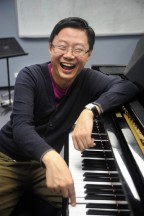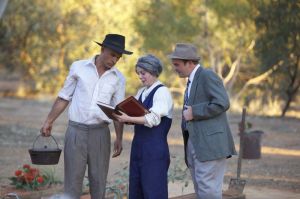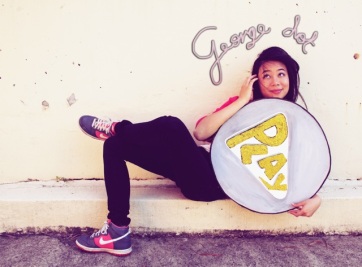Monthly Archives: March 2013
Meet Simon Chan, a James Bond fan and actor, theatre director, cabaret performer…
Simon Chan has a Graduate Diploma and Masters of Music from QUT and has worked for La Boite, the Queensland Theatre Company, Metro Arts, and acted in a number of films (including the feature The Real Macaw and the short Karaoke King with Anna Yen, directed by Carine Chai which was screened at the Asian Australian Occasion Short Film Festival curated by AAFFN’s Indigo Willing in 2007).
Chan has also been a theatre critic, and has presented with his creation The Other Production Company musical productions including The Velveteen Rabbit which has enjoyed international attention and a number of overseas invitations, as well as I Must Stop Looking At Men, and Closer To Heaven, a musical by Jonathan Harvey and the Pet Shop Boys, at the Brisbane Powerhouse. In 2007. Chan has also presented in association with Chris Maver Productions and the Judith Wright Centre cabaret material such as Gaysian in The Fruit Tingle Cabaret.
In 2012, Simon was approached by Brad Rush, producer at the Arts Centre Gold Coast, to create an original revue of his musical song works. The result was Rice & Easy, a cabaret of Simon’s songs with The Space transformed into a working Chinese Restaurant.
In 2013, Simon is working on a comedy revue of songs from spy films, called From Asia With Love, with Matt Ward (Chess, The Production Company, 2012) and Kimie Tsukakoshi (Miss Saigon, Savoyards, 2012). It will be presented by The Other Production Company in April/May.
Interview with Chris Raja, writer, teacher and playwright
Bio –
Chris Raja migrated to Melbourne from Calcutta in 1986, and almost twenty years later he moved again, further inland, to Alice Springs. An English and History teacher at St Philip’s College in Alice Springs, Chris was co-guest consultant editor of Meanjin’s Australasian issue in 2004 and since then has been a regular contributor to Quadrant, Southerly and Art Monthly Australia. His short story ‘After the Wreck’ was adapted for radio and broadcast on ABC Radio National’s Short Story Program in 2007. His play ‘Drew’s Seizure’ was performed at Araluen Arts Centre, Alice Springs in2009. Chris worked as the NT Correspondent for Art Monthly Australia from 2010 to 2011. He and his actor wife Natasha co-wrote ‘The First Garden’ with the assistance of a grant from Arts NT which premiered as part of the Alice Desert Festival inSeptember 2011. Chris has been selected for the Australian Society of Authors 2011/2012 mentorship program.
Synopsis of ‘The First Garden’ –
Olive Pink (1884 -1975) was a botanical illustrator, anthropologist, gardener and a trailblazing Aboriginal land rightsactivist and environmentalist. In October 1956, at the age of 72, Olive Pink set up her tent on the grounds of what is now the Olive Pink Botanic Garden and from this tranquil location she vigorously lobbied Northern Territory politicians to establish a Flora Reserve to protect native flora and provide a site where locals could visit and learnabout desert environments. ‘The First Garden’ is her story. The story of a woman who took no prisoners in her quest to develop her life’s dream; it is also the story of how diverse cultures have valuable lessons for each other.
How has your journeying from Calcutta to Melbourne, and then from Melbourne to Alice, influenced your creative practices?
When I was eleven, I moved from Calcutta to Australia. I am deeply connected to India and Australia and have used my artistic perspective to tell stories that deal with each country’s national psyche. Olive Pink is my subject for Australia and Indira Gandhi is my Indian subject.
In 2004 I moved to Alice Springs and found out about the trail blazing land rights activist, anthropologist, botanist, Olive Pink and her Warlpiri gardener Johnny Tjampitjinpa. For me this is one of the great Australian stories.
Living in the middle of the oldest continent on Earth, amongst the oldest tribal people, I have become interested in deep time. I have come to realise that the history of Australia is largely unwritten, misunderstood and swept under the carpet. Have we been emphasising the wrong history? I can’t believe that all the “Indigenous” Australians came from Africa via India at about the same time. There are so many marked differences between the different language groups in Australia.
The Warlpiri, Arrernte, Anangu people of the central Australian desert that I speak to remember the Indians, Pakistanis and Afghans and acknowledge how tough they were. By and large, it was because of the Indian, Pakistan and Afghan Cameleers and their Camels that the centre of Australia was penetrated. I live on Mohamed Street. When I tell my Indian family this, they are invariably amused: Mohammed Street? In Alice Springs? Who would have thought?
What was the experience of co-editing the Australasian issue of Meanjin like?
The experience of co-editing the Australasian issue of Meanjin in 2004 was wonderful and a real honour. It introduced me to a literary world. I got to read what other writers were writing about. I was mentored by Ian Britain and I learned the importance of good, clear writing. It made me curious to find out more about Australia. So straight after that issue, within a matter of weeks, I packed up and went to live in the desert, to work and live amongst Australia’s Indigenous people.
Is the work of Asian Australian creative practitioners (on screen, and in other mediums such as theatre and writing) getting enough attention in what we colloquially refer to as ‘mainstream Australia’?
Over time, I have come to realise that Australia and India are connected in much deeper ways than I could ever imagine. I’ve come across a number of stories that explore this.
The links and tensions in the Australian Indian relationship can be understood in many ways. The Indo Australia tectonic plate is an illustration of this. The Indo-Australian Plate is a major tectonic plate that includes the continent of Australia and surrounding ocean, and extends northwest to include the Indian subcontinent and adjacent waters. The large crustal plate includes the continent of Australia and the sub-continent of India but recent studies, and seismic events suggest that the Indo-Australian Plate may be in the process of breaking up into two separate plates due primarily to stresses induced by the collision of the Indo-Australian Plate with Eurasia along the Himalayas. The Indian subcontinent, Meganesia (Australia, New Guinea and Tasmania), New Zealand, and New Caledonia are all fragments of the ancient supercontinent of Gondwana that once dominated the world. Seafloor spreading separated these land masses from one another, but as the spreading centres became inactive, the land masses fused into a single plate.
It’s more than a hundred million years since Australia broke away from Gondwana. But by this time all kinds of plants and animals were well established. No other continent has stayed as isolated as Australia. Accordingly, this land literally became a life boat, a Noah’s ark for various plants and animals. Life in Australia evolved in a most distinct way for over a hundred million years. Isolation saved many ancient species including marsupials. Even today this isolation has its impacts and expression in various ways.
The Aboriginal people have been in Australia for a very long time. When they arrived is a mystery that is still not solved. Aboriginal culture and art stretches way back into prehistory. When Aboriginal people paint, they express ideas and traditions that go back many thousands of years but these secrets are kept and understood only within the initiated. In rock shelters, secrets were kept. Some of this art or history is so old and mysterious some people believe these secrets were made not by mortals but by spirits. This knowledge is sometimes referred to as the Jukurrpa. Jukurrpa (pronounced joo-kur-pa) is the Warlpiri spelling of the word which is often translated as Dreaming, Story or Law amongst Central Australian desert groupings or clans.
Curiously, the Indo Australia plate is undergoing stress and scientists believe it is going to rupture. The plate upon which Australia rests, extending from New Zealand all the way to the Himalayan ranges – is going to rupture and break in two, changing the very face of the Earth as we know it. 150 million years, when Australia was part of the southern super-continent Gondwana, the birth of the Indo-Australia plate occurred as Australia and India started to move northwards, away from Antarctica, breaking Gondwana apart. They joined to form the Indo-Australian plate we know today, which continues to push northward at six and a half centimetres a year. This event created enormous mountain ranges as it moved north interacting with the plates further north: the Himalayas, New Guinea, Timor, and also New Zealand off to the east.
Naturally, in the same way that the plate undergoes stress from time to time, connections between the two countries are strained from time to time. When I consider recent events such as student bashings or television shows such as ‘Dumb, Drunk and Racist’, I get embarrassed. Australia and India are old and great civilisations. They have deep links geographically and historically and I am proud to be a part of both.
How did you and your wife, Natasha Raja, get interested in writing the story of Olive Pink?
We feel ‘The First Garden’ is a unique, important story that helps explain Australia and its past, and where we as a nation finds ourselves now, better than many other stories we have encountered to date. We hope this simple story will contribute to the national narrative in a way that entertains and educates.
What are your hopes for ‘The First Garden’, and other upcoming projects?
So far I have been involved in trying to understand Territory Nomads, Olive Pink and her Warlpiri gardener, and in my upcoming novel, ‘The Burning Elephant’ I have tried to look at the assassination of Indira Gandhi.
‘The First Garden’ is published by Currency Press. My book, ‘The Burning Elephant’ starts with the assassination of Indira Gandhi and it is completely set in India; however, it is about a family’s journey to Australia. I used this national catastrophe to tell a smaller, more personal story.
You might not expect Olive Pink and Indira Gandhi to be comparable subjects, but for me they reflect a narrative that defines each of their countries. But there is so much more that I am keen to explore. I want to find out more about the Afghan stories and indeed the deeper historical, geographical and scientific connections between the two countries.
Interview with Chris Raja by AAFFN’s Sukhmani Khorana
Interview with Aileen Huynh – persona George Dot Play
Bio:
Aileen Huynh is a Sydney based Actor. She graduated from the Western Australian Academy of Performing Arts (WAAPA) Acting course in 2010. She also holds a Bachelor of Creative Arts in Performance from the University of Wollongong. In her solo pursuits she works under the title and persona George Dot Play, producing video works that merge her screen performance with digital technology. Recent works include Emotibeats, Got Rice and Eargasm. In 2011 she worked with Bodysnatchers and debuted her one woman show, Gobbledygook. Other recent Acting credits include A Land Beyond the River (Bondi Pavilion), A Quiet Night in Rangoon (New Theatre), Colour of Change directed by Pearl Tan (Joyhouse Productions) and Better Man (Fremantle Media).
Tell us a bit about what is George Dot Play and where folks can see this project?
George Dot Play is the title and persona I go by in the cyber world. I make short videos of myself attempting to look really cool with editing techniques and dropping funky beats. (Hopefully, it occasionally works!). It’s hard to explain, but you can see for yourself on the crazy, wonderful world of YouTube. My channel is at http://www.youtube.com/georgedotplay.
What are some of the things you loved about working on this project?
I love working on George Dot Play because it gives me the ability to completely run wild with my creativity. From my imagination I can make it reality, although, a lot of the time it turns out quite different from what I first set out to do, but that’s all part of the fun! I have also loved learning new digital techniques, which has widened my skills and has allowed me to make some really cool stuff!
What is the advantage of videos and the Internet to reach audiences?
One of the initial reasons why I started George Dot Play was because of the opportunities and benefits being online have. Immediately anyone around the world can see your work with a click. Being an Actor with an Asian background I also feel like the Internet is the right platform for me to try and find a wider, culturally diverse audience. However there are also some tough hurdles. With the online world becoming increasingly popular there is so much content being uploaded everyday. 72 hours of video are being uploaded to YouTube every minute! You can easily get lost in the crowd.
You also were filming for Khoa Do’s ‘Better Man’? What was your role and what is it like working in the more traditional format of TV?
‘Better Man’ is a four-part mini-series, which will air on SBS later this year. It is based on the story of convicted drug trafficker Van Nguyen, who was the last Australian to be executed on death row. I play the role of Kelly, one of Van’s close friends. Working on the format of TV is wonderful. You see all the puzzle pieces join together. There are so many people on set with different jobs and you’re employed to just focus on your job- to act. It’s very different to working on George Dot Play where you’re the actor, director, cameraman, editor, publicist etc all at the same time, but that’s what makes your creative work so satisfying, cause of all the blood, sweat (and sometimes tears) that have gone into it. It’s lovely though when a job (that’s also paid!) comes along and you can just focus on your performance, plus you always meet some wonderful people along the way.
You are also an artist in residence at Waverly Council. How do such opportunities assist artist like yourself and what project are you working on there?
Being an artist in residence with Waverley Council provides a great support network and some valuable resources to help produce your artistic work. They help you promote your work, give you contact and networking opportunities and supply you with a studio to work in for six months. All extremely useful tools for emerging artists like myself. I’m using the residency to work on new George Dot Play videos and my business strategies. Currently I’m working on an open call project called ‘The Bondi Groove’. So come down, join the party and be in one of my videos! Anyone and everyone is welcome! Details are here: George Dot Play The Bondi Groove
You are a recent Western Australian Academy of Performing Arts (WAAPA) grad. What are some of the best experiences you’ve drawn from that?
There are so many great memories and experiences I’ll take away from WAAPA. There may not be another time in my life where I will be able to focus so closely on the craft of performance like I did when I was there. I was very lucky to work on so many shows, be cast in roles that I will most likely never play in the ‘real world’, and learn lots of useful things to make me a better performer. At WAAPA you also make working and personal relationships that will last a lifetime.
Who are some of the people who have helped you along the way to where you are now and where you want to head?
There are many people who have helped shaped my choices as an artist and help me keep pursing my goals- A lot of close friends, colleagues, lecturers, and teachers. There have also been a number of people who I’ve met in random circumstances, who have ended up advocating my work and have been such valuable assets in the movements of my career. You never know where these people will spring from!
What is one of your dream projects?
I have so many dream projects I would love to be working on- Oh, lets say a role in a David Fincher, Tarantino or Paul Thomas Anderson film (have to start with the bar raised high right?), working with Freddie W on an online film, touring the world with a stage show. Gotta keep those dream options open!
Any final advice for young people out there planning to be filmmakers?
If you feel an absolute need to do it and there is no other choice, then do it. If you feel you could put your ambitions elsewhere and be just as happy…. well that might not be a bad idea. Could definitely help financially!
Interview with Aileen Huynh by AAFFN’s Indigo Willing.




